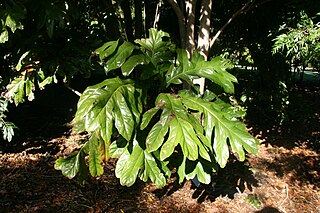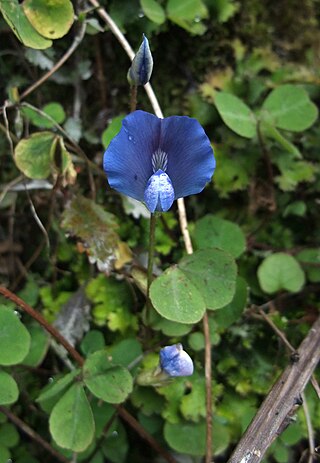
Athertonia is a monotypic genus of plants in the family Proteaceae. The sole described species is Athertonia diversifolia, commonly known as Atherton oak, athertonia, creamy silky oak or white oak. It is endemic to a small part of the Wet Tropics of Queensland, Australia. A relative of the macadamia, it has potential in horticulture and the bushfood industry.

Archontophoenix alexandrae, commonly known as Alexandra palm, king palm, northern Bangalow palm, or feather palm, is a palm endemic to Queensland, Australia. It was named in honour of Princess Alexandra of Denmark, but is often erroneously referred to by the misnomer Alexander palm.

Parochetus communis, known in English as shamrock pea or blue oxalis, is a species of legume, and the only species in the genus Parochetus and in the subtribe Parochetinae. It is a low-growing plant with blue papilionaceous flowers and clover-like leaves. It is found in the mountains of Asia and tropical Africa, and has been introduced to New Zealand.
Erythrina schliebenii is a species of legume in the family Fabaceae. It is found only in Tanzania. The species is named for German collector and botanist Hans-Joachim Schlieben.
Hopea semicuneata is a tree in the family Dipterocarpaceae. The specific epithet semicuneata means "half wedge-shaped", referring to the leaf base.

Angiopteris evecta, commonly known as the king fern, giant fern, elephant fern, oriental vessel fern, Madagascar tree fern, or mule's Foot fern, is a very large rainforest fern in the family Marattiaceae native to most parts of Southeast Asia and Oceania. It has a history dating back about 300 million years, and is believed to have the longest fronds of any fern in the world.

Goniocheton arborescens, commonly known in Australia as Mossman mahogany, is a small tree in the mahogany family Meliaceae. It is native to rainforests of Malesia, Papuasia, Queensland and nearby islands.
Droogmansia pteropus is a plant in the legume family Fabaceae, native to southern tropical Africa.

Brownea macrophylla is a tree in the legume family Fabaceae. The specific epithet macrophylla means 'large-leaved'.
Adenodolichos kaessneri is a plant in the legume family Fabaceae, native to central Africa.
Adenodolichos acutifoliolatus is a plant in the legume family Fabaceae, native to Tanzania.
Adenodolichos paniculatus is a plant in the legume family Fabaceae, native to tropical Africa. The specific epithet means 'with panicles', referring to the plant's many-branched inflorescence.
Adenodolichos punctatus is a plant in the legume family Fabaceae, native to tropical Africa.
Adenodolichos baumii is a plant in the legume family Fabaceae, native to tropical Africa.
Adenodolichos exellii is a plant in the legume family Fabaceae, native to tropical Africa.
Adenodolichos huillensis is a plant in the legume family Fabaceae, native to Angola and Zambia.
Adenodolichos rhomboideus is a plant in the legume family Fabaceae, native to tropical Africa.

Cabobanthus polysphaerus is a plant in the family Asteraceae, native to tropical Africa.
Oocephala agrianthoides is a plant in the family Asteraceae, native to Central Africa.

Polhillides velutina is a species of flowering plant in the legume family, Fabaceae. It is the sole species in the genus Polhillides. It is an annual, perennial or sub-shrub, that is native to tropical regions of Africa and Madagascar, parts of Asia, New Guinea, and Australia. In Africa, its habitats include woodland and grassland in the Sudanian region, wooded grassland and grassland in the Victoria Basin forest–savanna mosaic, and wooded grassland and grassland in the Somalia-Masai region. It is found at elevations of up to 1,320 m (4,330 ft) above sea level.







